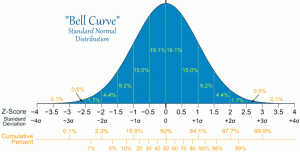Moving the Curve
 The premeditated act of race fitness.
The premeditated act of race fitness.
I don’t know what your fitness goals are. Maybe you want to lose weight or feel better or be able to chase down your grandkids.
I do know my goal and it is none of those things. It is actually much less nuanced and much more simple. I want, I need, to run a certified marathon course in less than 3 hours and 30 minutes before September.
Because of the exactitude of this goal directing my efforts becomes much easier. I know exactly how fast I have to go for how long. This turns training and fitness into a mathematical equation of sorts. If I can train at X then I can race at Y.
For example, people will tell me that being able to do 10 Yasso 800’s at less than 3 minutes and 30 seconds would prove that I’m fit enough to race my goal. While I’ll admit that this, among other indicators, is a good, positive and hopeful sign, it is not a guarantee.
We humans like to think linearly like this. We area masters at assuming and trying to impose quantitative order on the chaos of existence. Whether we like it or not existence usually ignores us.
Training and fitness, like all things human, are non-linear. There is no straight line between X and Y.
Certainly there is directional certainty. X does indeed directly influence Y. If you don’t do that training your probability of achieving that finishing goal drops significantly.
Probability, my friends is the key word and key concept here that we have to understand if we want to come to grips with how our training relates to our race goals.
If I look across the dozens of marathons I have run I can compare my times. I can also compare how my times lined up with my training quality and my expectations. I have not done this explicitly but I can tell you how it would look. It would be a curve.
Most people when they are putting together their goals for a marathon they will set 3 time goals. One is their ‘A’ goal. This is the time they hope to run if everything goes well. The ‘A’ goal is typically a bit of a stretch goal.
The ‘B’ goal is the time they think is the most probable based on their experience and training. The ‘C’ goal is what they will settle for if they have a bad day.
How does this relate to probability of me meeting my goals and why do you care?
If you look at these goals you can already see that it is a probability curve. It is what is referred to as the ‘Normal Distribution’ curve or ‘bell’ curve. If you were to plot all the potential finishing times and their probabilities it would be a bell curve, just like the one they use for grading kids in school.
I’m going to stop talking about math now and try to extract back to the point I was trying to make.
The point I was trying to make is that your projected finishing time is non-linear, and the influence of your training on your finishing time is also non-linear. It is stochastic. That simply means that there is a level of uncertainty in this whole process.
That’s it. I dragged you through all that simply to support the fact that your finishing times are uncertain and even though your training influences them, that influence is uncertain as well.
This is all very confusing and maybe de-motivating for you folks who like certainty, but there is a silver lining. The silver lining is that the amount of uncertainty can be removed through training.
There are influences to our finishing times that are outside of our control and there are influences within our control. The trick of training is to ‘move the curve’ by directing energy to those things that you can control and not worrying about those things that you cannot control.
When I train for a specific finishing time what I am doing is moving my fitness so that the probability of meeting that time goal increases. I am trying to remove uncertainty from the equation and narrow the bell curve.
Running is a very specific sport. Racing is a very specific goal set. My ability to run a 3:30 marathon is a function of Pace over Time. Therefore, in my training I focus on creating the ability to maintain a specific pace over time.
I know that no volume or intensity of training will guarantee a finishing time. I also know that I can move the curve. I can move the whole curve. I can shift the entire finishing time probability to the right.
In this way you make your probability of meeting not only your goal time, you increase the probability of achieving all faster times.
What is the takeaway?
First, understand what influencers you control and what you don’t. You can’t control the weather on race day, but you can control your diet and whether or not you get out of bed to get your training done.
Second, understand specifically what in your training has the greatest influence on moving the curve. We all only have so much time and energy. The more you can isolate, understand and focus on the things that make a difference and have the most influence, the more you can influence the curve.
Third, never think in terms of discrete finishing times. Think of your training as giving you the best chance, the best odds, the highest probability along your curve.
Oh no! It turns out that math they made you learn in high school was good for something…
